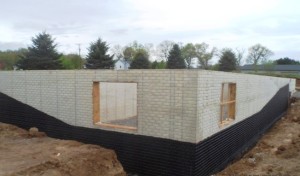Poured Concrete Foundation versus Block Foundation
How does a poured concrete foundation work than the block foundation? Poured concrete is more popular for basement construction than block because it is seamless and resists water intrusion better. Poured concrete walls are created through a continuous pour to ensure good bonding and to avoid seam cracking where a first concrete layer has already set.
Temporary forms of concrete walls are usually taken down after one week, at which time the concrete is cured enough to support itself. The concrete will continue to cure and emit moisture for much longer. However when using insulated poured concrete forms, they remain in place and insulate the home.
Reinforced Block and Concrete Walls
Block foundations use cinder blocks that are stacked on each other and cemented in place with mortar. The process starts on the top of the footings with each row forming its own course. The blocks are then reinforced with rebar placed vertically in the holes or cells and filled with concrete.
Block walls can also be used to form stem walls that support a slab above. When building stem walls, block courses on footings are set below grade and reinforced with rebar before concrete is poured in a continuous pour for a seamless, integral slab. Stem-wall slab foundations prevent water intrusion and the separation of the slab from the substrate that can be caused by uplift or hydrostatic pressure.
Both poured concrete and block foundations are reinforced with rebar. With poured concrete walls, a pencil vibrator is inserted into the slurry to vibrate the concrete into place and ensure there are no air pockets or voids left in the wall.
Finishing the Basement Floor with Poured Concrete
When building slab foundations, the poured concrete comes after the footings have set and before walls are erected. Dirt is compacted and backfilled with four to six inches of gravel. Typically, a polyethylene sheet provides a vapor barrier between the soil and the slab. A two-inch layer of sand goes on top of the vapor barrier, followed by a wire-mesh grid that reinforces the concrete. If radiant in-floor heating will be used, the plastic tubing is placed on top of the wire mesh. Once the tubing is pressure-tested, the four-to-six-inch concrete slab is poured.
When building with poured concrete walls, the basement floor is prepared as if it were a slab floor, often with the concrete floor poured after the top floors are in place and the roof, windows, and doors are set.
Basement plumbing for floor drains and piping must be roughed in before the pour. Like a slab floor, the basement floor will be lined with a six-inch aggregate bed followed by a six-mil polyethylene vapor barrier. One to two inches of foam board can go on top of the vapor barrier for insulation and further waterproofing. Wire mesh comes next for structural strength, and flex tubing is set in place if using in-floor radiant heating. Finally, the concrete is poured on top and leveled with a screed.
In case you still have question about modular homes and insulated precast foundation, you may contact Legendary Homes Inc in Jackson, Michigan. A representative will be happy to assist you. Meanwhile you can check our modular home price sheets by signing up to our blog



